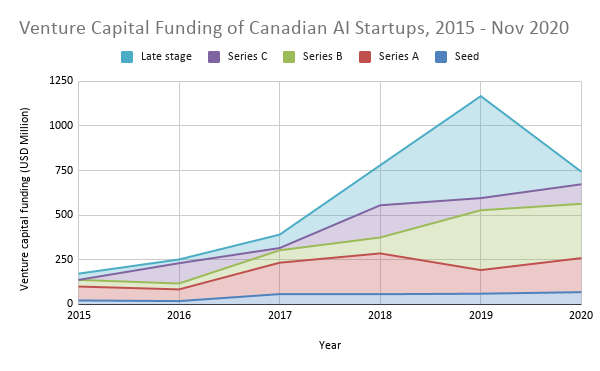I was working at the Creative Destruction Lab (CDL) when we launched its first accelerator program focused exclusively on machine learning (ML) companies, an initiative strongly encouraged by Radical Ventures co-founder Tomi Poutanen, who was a founding mentor at CDL. The inaugural cohort in 2015 consisted of 25 machine learning companies, including two that travelled to Toronto from Silicon Valley and Paris, France.
What a difference five years can make. The AI ecosystem in Canada is booming. And as we wrap up the first year of a new decade, and mark just under 20 months since launching Radical Ventures Fund II, we spent some time analyzing venture capital investments in Canadian AI startups from 2015 to 2020.
Our analysis shows there are 1,226 AI startups headquartered in Canada that have raised an estimated US$3.8 Billion in venture funding between January 2015 and November 2020.¹
(A caveat on our methodology. The scope of what constitutes an AI company continues to expand and private startup investment is not always made public. The dataset we analyzed is from Tracxn and includes only publicly disclosed investment rounds. Anecdotally, we estimate our analysis under-represents the amount of capital going into this category by about 25%.)

When comparing our analysis to data from the Canadian Venture Capital Association (CVCA) we note that AI investments in the first three quarters of 2020 (~$743M) represented ~23% of the total VC investment in the country over the same period (~3.5B), and was up slightly from 19% in 2019. Despite the increase in total funds raised in 2019, the number of investment events dropped from 2018, signalling a higher amount raised per funding round. Looking at the makeup of funding each year, funding across each stage is up through 2018 with a large increase in late stage capital in 2019 for some mega deals.
Today, the ML tracks at CDL are flourishing, attracting over 240 AI companies a year from around the world – a reflection of Canada’s rich startup community. Looking back, one of the important things learned in those early days of CDL was the power of convening a small group of accomplished entrepreneurs and investors working in one domain (machine learning), and how it would attract other like-minded individuals over time until a critical mass was built that would have a self-sustaining momentum.
This philosophy of building critical mass has been the basis of the work Tomi and Radical co-founder Jordan Jacobs have done in helping to build the Canadian AI community through their startup Layer 6, the conception and co-founding of the Vector Institute for AI, and their co-writing of the Pan-Canadian AI Strategy (the world’s first national AI strategy). This philosophy also guides Radical Ventures, one of the world’s largest AI-focused funds, as we seek to build a network of portfolio companies and the supporting infrastructure of AI researchers and other specialists to help these AI startups achieve global scale.
¹ Excludes public companies, those backed by private equity funds, and companies with undisclosed funding rounds.
5 Noteworthy AI and Deep Tech Articles: week of Dec 21, 2020
1. How Canada is fighting the war on talent (MaRS)
Despite the terrible toll of the pandemic, the market for technology jobs in Canada remains resilient. There are nearly 100,000 more jobs now in STEM (Science, Technology, Engineering and Math) disciplines in this country than there were before the pandemic.
2. Tiny four-bit computers are now all you need to train AI (MIT Technology Review)
IBM researchers are proposing to decrease the number of bits, or 1s and 0s, needed to represent data. Reducing the current industry standard of 16 bits to only four, would increase the speed of training deep learning models by more than sevenfold and reduce energy consumption. With fewer bit requirements, efficient training platforms could migrate to smartphones and other small devices.
3. Smarter Traffic Lights, Calmer Commutes (New York Times)
Less painful commutes may be ahead, with advanced electronic control systems that apply artificial intelligence to the task of keeping traffic moving. Less time stuck in traffic, multiplied by many thousands of commuters, can lead to less fuel burned and less carbon emitted. As new technologies evolve and vehicles become smarter, intelligent adaptive control systems are likely to become the norm.
4. Predictive surveillance: Can artificial intelligence eliminate healthcare-associated infections? (MedCityNews)
By powering clinical surveillance systems with AI, health systems can proactively identify an expanding range of acute and chronic health conditions with greater accuracy and expediency. This will enable hospitals and communities to act before clusters, outbreaks, or critical medical emergencies escalate.
5. Artificial intelligence classifies supernova explosions with unprecedented accuracy (SpaceRef)
By training a machine learning model to categorize supernovae based on their visible characteristics, astronomers were able to classify supernovae with an accuracy rate of 82%. The data sets from the new machine learning algorithm will be made publicly available.
Radical Reads is edited by Ebin Tomy.

